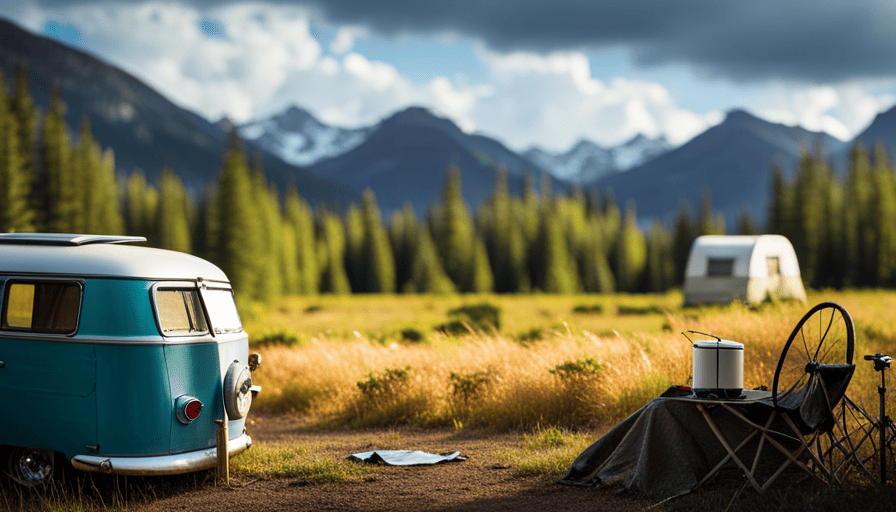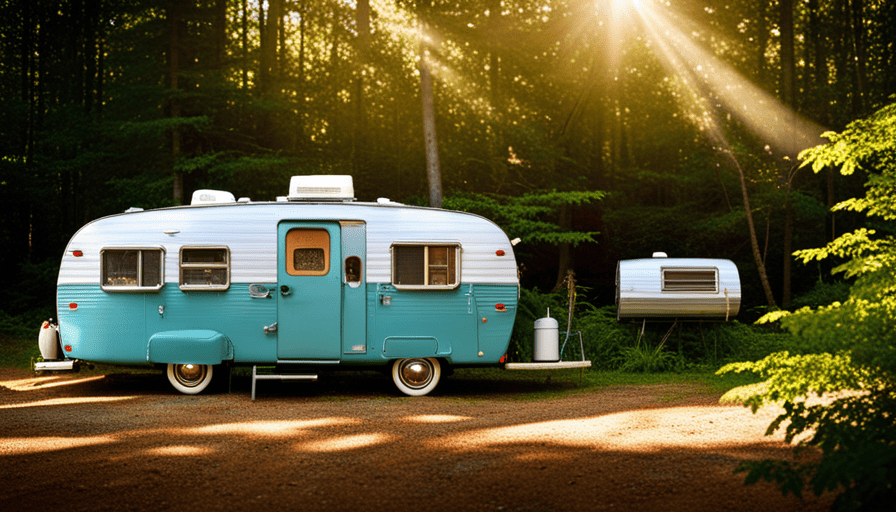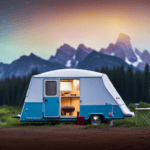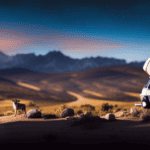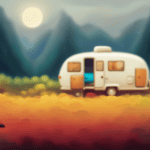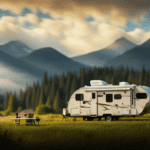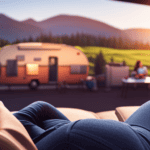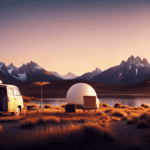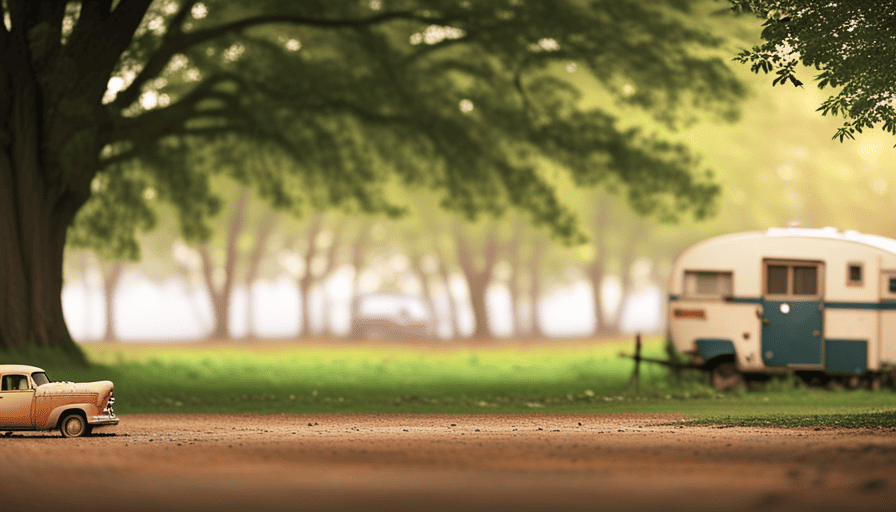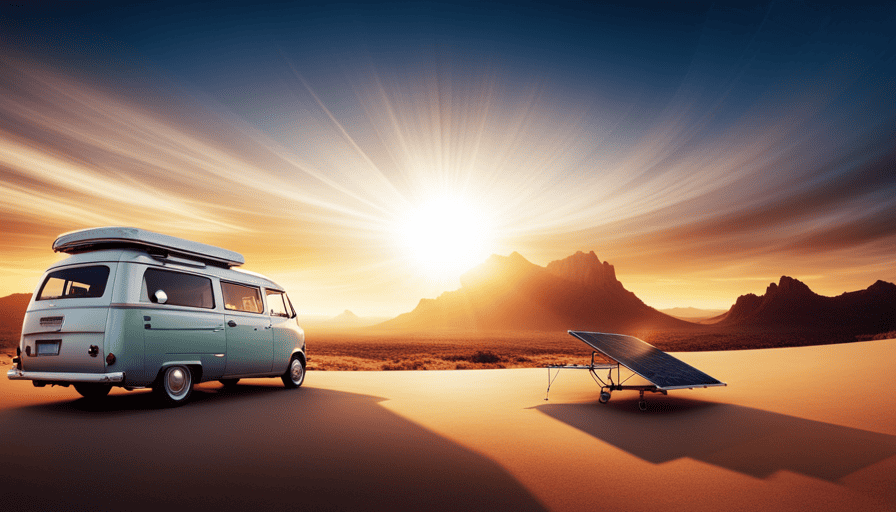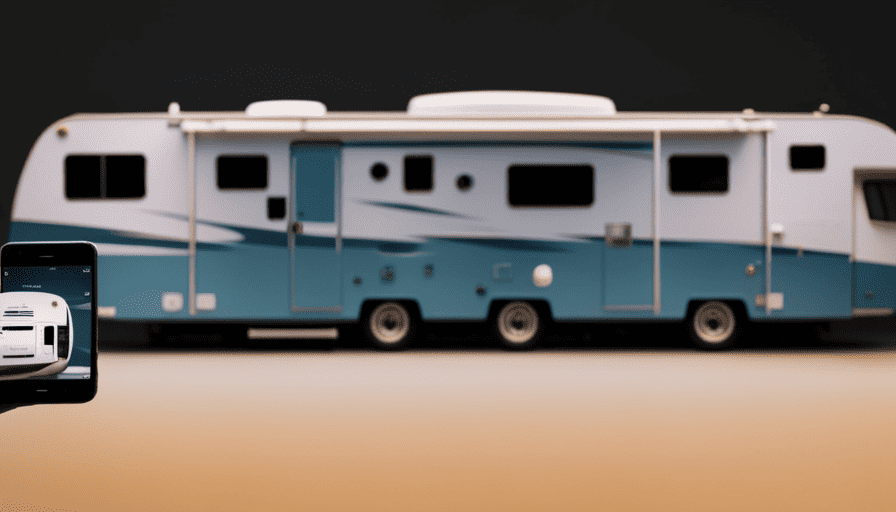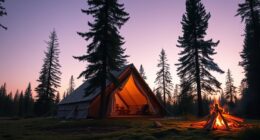In the vast natural world, where mountains touch the sky and rivers carve their way through the landscape, lies the allure of the open road and the freedom that comes with a life on the move. However, amidst this beautiful scenery, a persistent question lingers: how can one stay connected to the wider world while living a nomadic lifestyle?
Fear not, fellow wanderer, for I have embarked on a quest to unveil the secrets of getting internet in your camper. Through meticulous evaluation of your internet needs, researching mobile hotspot options, and choosing a reliable network provider, you can pave the way to a digital oasis on wheels.
With the aid of a WiFi booster or extender, you can amplify your signal strength and truly harness the power of the online realm. And for those traversing the most remote corners of the world, satellite internet services and portable WiFi solutions await.
So, my fellow road-tripper, let us unravel the mysteries of connectivity and embark on a camper adventure like no other.
Key Takeaways
- Mobile hotspots create Wi-Fi networks using cellular data and provide stronger signal and faster speeds.
- Tethering allows using the smartphone’s data connection for internet access but may have slower speeds and drain battery.
- Campground Wi-Fi may be unreliable, but choosing a campsite close to the WiFi hotspot or investing in a WiFi antenna or range extender can improve the connection.
- Consider options like Wi-Fi boosters, satellite internet, or portable WiFi solutions to enhance connectivity and provide benefits like enhanced signal strength, expanded coverage, and multiple device support.
Evaluate Your Internet Needs
Before you hit the road, take a moment to evaluate your internet needs and determine what type of connection will best suit your camper lifestyle.
Determining your requirements is crucial to ensure you have a reliable and efficient internet connection while on the go. Start by assessing your connectivity options based on factors such as speed, coverage, and cost. Consider how much data you need and what activities you’ll be using the internet for, whether it’s basic browsing, streaming movies, or online gaming.
If you plan to stay in RV parks or campgrounds with Wi-Fi, you may be able to rely on their provided internet. However, keep in mind that these connections can be unreliable or slow, especially during peak times.
If you need a more dependable option, research mobile hotspot options. These devices use cellular networks to provide internet access, allowing you to connect multiple devices simultaneously. Look for providers that offer good coverage in the areas you plan to travel and compare data plans to find the best fit for your needs.
Evaluate your internet needs and determine the connectivity option that suits you best. Once you have a reliable connection, you can enjoy all the conveniences and entertainment the internet has to offer while exploring the great outdoors.
Research Mobile Hotspot Options
Explore various mobile hotspot options to effortlessly connect your camper to the vast world of online possibilities. When it comes to getting internet in your camper, two popular options are mobile hotspots and tethering.
A mobile hotspot is a device that creates a Wi-Fi network using cellular data, allowing you to connect multiple devices to the internet. On the other hand, tethering involves using your smartphone’s data connection to provide internet access to other devices.
There are pros and cons to both options. Mobile hotspots offer the advantage of being separate devices, meaning you can use them without draining your phone’s battery. They also usually have a stronger signal and can provide faster speeds. However, they require a separate data plan and can be more expensive than tethering.
Tethering, on the other hand, allows you to use your existing smartphone data plan, saving you money. However, it can drain your phone’s battery quickly and may not provide the same fast speeds as a dedicated hotspot device.
As you consider your options, think about your budget, data needs, and the reliability of your chosen network provider. This will help you make an informed decision about which option is best for you.
Transitioning into the next section, choosing a reliable network provider will ensure a seamless internet experience in your camper.
Choose a Reliable Network Provider
When it comes to staying connected on the road, it’s crucial to choose a reliable network provider for seamless online experiences in your mobile home.
To ensure a stable and fast internet connection while traveling, it’s important to compare different network providers and determine the cost of internet access. Start by researching the various network providers available in your area and compare their coverage maps to see which one offers the best coverage for your travel destinations. Consider factors such as network reliability, speed, and customer reviews to determine the most reliable option.
Once you’ve narrowed down your options, consider the cost of internet access for each provider. Compare their data plans, pricing, and any additional fees or charges that may apply. Some providers offer unlimited data plans, while others have tiered plans based on usage. It’s important to choose a plan that fits your internet usage needs and budget.
By choosing a reliable network provider, you can ensure a smooth and uninterrupted internet experience in your camper. With a reliable network in place, you can now move on to the next step of setting up a mobile hotspot and enjoying internet access wherever you go.
Set Up a Mobile Hotspot
Once you’ve chosen a reliable network provider, it’s time to set up your mobile hotspot for convenient internet access on the go. Having a mobile hotspot allows you to connect your devices to the internet using cellular data. Here are four important things to consider when setting up your mobile hotspot:
-
Mobile hotspot coverage: Before you begin, make sure to check the coverage map provided by your network provider. This will help you determine if the area you plan to travel in has a strong enough signal for reliable internet access.
-
Mobile hotspot data plans: It’s essential to understand the data plans offered by your network provider. Consider your internet usage needs and choose a plan that provides sufficient data for your activities while on the road.
-
Security settings: Protecting your mobile hotspot is crucial to prevent unauthorized access. Set up a strong password and enable security features such as WPA2 encryption to keep your connection secure.
-
Device compatibility: Ensure that your devices are compatible with your mobile hotspot. Most smartphones have built-in hotspot capabilities, but if you plan on using a separate hotspot device, check its compatibility with your devices.
Once your mobile hotspot is set up, you can consider installing a wifi booster to extend your signal range and improve internet connectivity in your camper.
Consider Installing a WiFi Booster
Enhance your mobile hotspot experience by installing a WiFi booster to amplify your signal strength and extend connectivity in your mobile oasis. A WiFi booster, also known as a WiFi range extender, can significantly improve your internet connection while on the road. It works by capturing the existing WiFi signal and then rebroadcasting it, thus increasing the range and coverage area.
By installing a WiFi booster in your camper, you can enjoy several benefits. Firstly, it enhances the signal strength, allowing you to have a more stable and reliable internet connection. This is particularly useful when you are parked in remote areas with weak WiFi signals. Secondly, a WiFi booster extends the range, enabling you to access the internet from a greater distance away from the source. Lastly, it can support multiple devices simultaneously, so everyone in your camper can connect to the internet without any issues.
When installing a WiFi booster, there are a few tips to keep in mind. Firstly, position it in a central location within your camper to maximize coverage. Avoid placing it near large metal objects or other electronic devices that may interfere with the signal. Secondly, make sure to follow the manufacturer’s instructions for installation and setup. Lastly, regularly check for firmware updates to ensure optimal performance.
Now that you have enhanced your mobile hotspot with a WiFi booster, let’s explore another option to get internet in your camper: utilizing campground WiFi.
Utilize Campground WiFi
After considering the option of installing a WiFi booster, I realized that there’s another way to get internet in my camper: by utilizing campground WiFi.
Many campgrounds nowadays offer WiFi for their guests, and it can be a convenient and cost-effective solution for staying connected while on the road.
To maximize campground WiFi, there are a few things I can do. First, I can make sure to choose a campsite that’s close to the WiFi hotspot, as this’ll likely result in a stronger and more reliable connection. Additionally, I can invest in a WiFi antenna or range extender, which can help boost the signal and improve the overall performance of the campground WiFi.
However, it’s important to note that campground WiFi can sometimes be slow or unreliable, especially if there’re many people using it at once. In such cases, it’s good to have alternative internet options available. This could include having a mobile hotspot device or a data plan on my smartphone, which can provide a backup connection if needed.
In the next section, I’ll explore the option of investing in a WiFi extender, which can further enhance my internet capabilities in the camper and ensure a more consistent connection.
Invest in a WiFi Extender
To improve your connectivity while camping, consider investing in a WiFi extender for a stronger and more reliable connection. A WiFi extender is a device that amplifies and extends the range of your existing WiFi signal, allowing you to access the internet from a greater distance. Here are five benefits of using a WiFi extender:
-
Enhanced Signal Strength: With a WiFi extender, you can enjoy a stronger and more stable internet connection in your camper, even if you’re far away from the campground’s WiFi source.
-
Expanded Coverage: A WiFi extender increases the coverage area of your WiFi network, ensuring that you have internet access throughout your camper.
-
Multiple Device Support: WiFi extenders allow multiple devices to connect to the internet simultaneously, so you and your fellow campers can all stay connected.
-
Easy Installation: Setting up a WiFi extender is usually a straightforward process that can be done by following the manufacturer’s instructions.
-
Cost-effective Solution: Investing in a WiFi extender is often more cost-effective than opting for other solutions, such as using a mobile hotspot or satellite internet.
By investing in a WiFi extender, you can significantly improve your internet connectivity while camping. However, if you’re looking for an even more reliable connection, you may want to consider using a satellite internet service.
Use a Satellite Internet Service
If you’re looking for a more reliable way to stay connected while camping, consider using a satellite internet service – it’s like having the world at your fingertips, even in the great outdoors! Satellite internet offers a viable alternative to cellular internet when you’re in remote locations with limited or no cellular coverage.
To help you understand the differences between satellite and cellular internet, let’s compare their pros and cons:
| Satellite Internet | Cellular Internet |
|---|---|
| Reliable in remote areas | Dependent on cellular coverage |
| Faster speeds | Slower speeds in rural areas |
| Wide coverage range | Limited coverage in remote regions |
| Unaffected by network congestion | Slower during peak times |
| Requires a satellite dish | Requires a cellular tower |
While satellite internet provides reliable and fast connectivity in remote areas, it does come with a few drawbacks. Setting up a satellite dish can be cumbersome, and the service may be more expensive compared to cellular internet. Additionally, satellite internet can experience latency due to the long distance signals have to travel between the satellite and your camper.
In the next section, we will explore portable WiFi solutions that offer flexibility and convenience for campers on the go.
Explore Portable WiFi Solutions
Discover the convenience and flexibility of portable WiFi solutions that keep you connected while camping in remote areas. When it comes to getting internet in your camper, a portable router and internet antenna are essential tools.
These devices allow you to create your own WiFi network and connect to the internet wherever you go. A portable router is a compact device that acts as a hub for your internet connection. It can be easily set up in your camper and provides a secure WiFi network for all your devices. Some portable routers even have built-in battery packs, allowing you to stay connected even when you’re off-grid.
To enhance your internet connection, you can also invest in an internet antenna. This device helps boost the signal strength and range of your WiFi network, ensuring a reliable and fast connection. Internet antennas are designed to be easily mounted on your camper’s roof or exterior, and they can significantly improve your internet experience in remote areas.
With a portable router and internet antenna, you can stay connected and enjoy your camper adventure to the fullest. Whether you’re checking emails, streaming movies, or video chatting with friends and family, these portable WiFi solutions ensure that you’re always connected, no matter where you are on your camper journey.
Stay Connected and Enjoy Your Camper Adventure
When it comes to exploring portable WiFi solutions for my camper, I’ve found that staying connected is essential for a successful and enjoyable adventure. Now, let’s dive into the current subtopic and discuss the various camper internet options available and the benefits of staying connected.
-
Mobile Hotspot: One option is to use a mobile hotspot device, which allows you to connect to the internet using cellular data. It provides flexibility and convenience, especially when traveling to remote areas.
-
Campground WiFi: Many campgrounds offer WiFi access, allowing you to stay connected without using your own data. However, it’s important to note that the quality and speed of campground WiFi can vary.
-
Satellite Internet: For those who venture off-grid and still require a reliable internet connection, satellite internet is an excellent option. It provides coverage in even the most remote locations.
-
WiFi Extender: To boost the signal of existing WiFi networks, you can use a WiFi extender. This device amplifies the signal, ensuring a stronger and more stable connection.
Staying connected in your camper has numerous benefits. It allows you to stay in touch with loved ones, stream entertainment, research nearby attractions, and even work remotely if needed. With these camper internet options, you can stay connected and make the most of your camper adventure.
Frequently Asked Questions
Can I use my camper’s existing WiFi antenna to boost the signal?
Yes, you can use your camper’s existing WiFi antenna to boost the signal by using a WiFi extender. A WiFi extender acts as a bridge between your existing WiFi network and your camper, enhancing the signal strength and range.
Additionally, you can also consider installing a cellular signal booster, which amplifies the cellular signal to provide a more reliable internet connection.
Both options can greatly improve your internet experience while on the road.
What are the benefits of using a satellite internet service over a mobile hotspot?
The benefits of using a satellite internet service over a mobile hotspot are numerous. Firstly, satellite internet offers a much wider coverage area, allowing me to have reliable internet access even in remote locations.
Additionally, satellite internet typically provides faster speeds and more consistent performance, which is crucial for activities such as streaming or video conferencing.
Lastly, satellite internet eliminates the need for relying on a cellular network, providing a more stable and reliable connection overall.
How can I ensure a stable and reliable internet connection while on the road?
To ensure a stable and reliable internet connection while on the road, there are a few key steps I follow. Firstly, I invest in a reputable mobile hotspot or satellite internet service. This ensures a consistent connection wherever I go.
Secondly, I make sure to position my camper in areas with strong signal reception.
Lastly, I regularly update and maintain my devices and equipment to ensure optimal performance. By following these steps, I can enjoy a stable and reliable internet connection while traveling.
Are there any limitations or restrictions to using campground WiFi?
There are indeed limitations and restrictions to using campground wifi. While it may be convenient, the speed and reliability can vary greatly.
Many campgrounds have limited bandwidth, which means that the connection can be slow and unreliable, especially if many people are using it at the same time.
Additionally, some campgrounds may have restrictions on the types of websites or activities allowed, such as streaming or downloading large files.
What are the best portable WiFi solutions for campers?
When it comes to portable wifi solutions for campers, there are a few options to consider. One popular choice is portable wifi routers. These routers allow you to create your own personal wifi network wherever you go. They are compact and easy to use, providing a reliable internet connection for your camper.
Additionally, it’s important to look into data plans that suit your needs. Make sure you have enough data to stay connected while on the road.
Conclusion
In conclusion, finding internet in your camper can be a daunting task, but with careful research and consideration, you can stay connected while enjoying your adventure.
Remember to evaluate your internet needs and choose a reliable network provider. Setting up a mobile hotspot, installing a WiFi booster, or investing in a WiFi extender are all great options to enhance your connectivity.
Additionally, exploring satellite internet services and portable WiFi solutions can provide reliable internet access no matter where your camper takes you. So, stay connected and let the internet be your guiding star on your camper journey.

